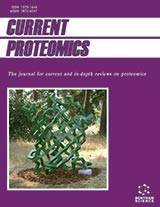Abstract
Efficient sample preparation in the micro and nano-litre range, prior to analysis of proteins and peptides of biological origin by liquid chromatography (LC), liquid chromatography coupled to mass spectrometry (LC-MS), micro- liquid chromatography (μ-LC) and matrix assisted laser desorption/ionization-time of flight (MALDI-TOF) mass spectrometry, is the key to success for different applications, such as biomarker discovery. Sample preparation in proteomics mainly comprises purification and preconcentration by solid-phase extraction (SPE) using different polymers (polystyrene, poly acrylate, cellulose, etc.) as a stationary phase following several cleaning-up procedures. These polymers can be derivatized with several functional groups, for example, C18, ion-exchanger or immobilized metal affinity chromatography (IMAC) groups. Based on these "traditional" techniques new methods enabling higher selectivity, sensitivity and speed of separation are required. Capillary coatings, for example, with latex particles has been used successfully. Derivatization of these latex particles, for example, with IMAC-functional groups enables a selective purification of phosphorylated or His-tagged proteins. Alternatively, polymeric disks possessing a thickness of approximately 2 mm can be used even in the case of multidimensional separations. In this review, we summarize currently available sample pretreatment techniques, provide an overview on the technical background and discuss the advantages of the individual methods using recently developed selective stationary phases such as silica based materials, polymers, etc.
Keywords: Purification, preconcentration, solid-phase extraction, capillary coatings, proteomics, desalting, mass spectrometry
Current Proteomics
Title: Sample Preparation Techniques for Mass Spectrometry in Proteomics Using Recently Developed Highly Selective Materials
Volume: 2 Issue: 4
Author(s): Christian W. Huck, Rania Bakry and Gunther K. Bonn
Affiliation:
Keywords: Purification, preconcentration, solid-phase extraction, capillary coatings, proteomics, desalting, mass spectrometry
Abstract: Efficient sample preparation in the micro and nano-litre range, prior to analysis of proteins and peptides of biological origin by liquid chromatography (LC), liquid chromatography coupled to mass spectrometry (LC-MS), micro- liquid chromatography (μ-LC) and matrix assisted laser desorption/ionization-time of flight (MALDI-TOF) mass spectrometry, is the key to success for different applications, such as biomarker discovery. Sample preparation in proteomics mainly comprises purification and preconcentration by solid-phase extraction (SPE) using different polymers (polystyrene, poly acrylate, cellulose, etc.) as a stationary phase following several cleaning-up procedures. These polymers can be derivatized with several functional groups, for example, C18, ion-exchanger or immobilized metal affinity chromatography (IMAC) groups. Based on these "traditional" techniques new methods enabling higher selectivity, sensitivity and speed of separation are required. Capillary coatings, for example, with latex particles has been used successfully. Derivatization of these latex particles, for example, with IMAC-functional groups enables a selective purification of phosphorylated or His-tagged proteins. Alternatively, polymeric disks possessing a thickness of approximately 2 mm can be used even in the case of multidimensional separations. In this review, we summarize currently available sample pretreatment techniques, provide an overview on the technical background and discuss the advantages of the individual methods using recently developed selective stationary phases such as silica based materials, polymers, etc.
Export Options
About this article
Cite this article as:
Huck W. Christian, Bakry Rania and Bonn K. Gunther, Sample Preparation Techniques for Mass Spectrometry in Proteomics Using Recently Developed Highly Selective Materials, Current Proteomics 2005; 2 (4) . https://dx.doi.org/10.2174/157016405775201748
| DOI https://dx.doi.org/10.2174/157016405775201748 |
Print ISSN 1570-1646 |
| Publisher Name Bentham Science Publisher |
Online ISSN 1875-6247 |
 1
1
- Author Guidelines
- Bentham Author Support Services (BASS)
- Graphical Abstracts
- Fabricating and Stating False Information
- Research Misconduct
- Post Publication Discussions and Corrections
- Publishing Ethics and Rectitude
- Increase Visibility of Your Article
- Archiving Policies
- Peer Review Workflow
- Order Your Article Before Print
- Promote Your Article
- Manuscript Transfer Facility
- Editorial Policies
- Allegations from Whistleblowers
Related Articles
-
Surface Binding of Toxins and Heavy Metals by Probiotics
Mini-Reviews in Medicinal Chemistry On the Nature of the Tumor-Initiating Cell
Current Stem Cell Research & Therapy Multi-target Drug Discovery via PTML Modeling: Applications to the Design of Virtual Dual Inhibitors of CDK4 and HER2
Current Topics in Medicinal Chemistry Update on the Rheumatologic Manifestations of Malignancy
Current Cancer Therapy Reviews Apoptosis-related BCL2-family Members: Key Players in Chemotherapy
Anti-Cancer Agents in Medicinal Chemistry Flavonoid-Based Cancer Therapy: An Updated Review
Anti-Cancer Agents in Medicinal Chemistry Multiple Means by Which Nitric Oxide can Antagonize Photodynamic Therapy
Current Medicinal Chemistry B Cell Modulation Strategies in Autoimmunity: The SLE Example
Current Pharmaceutical Design Emerging Indications for Statins: A Pluripotent Family of Agents with Several Potential Applications
Current Pharmaceutical Design Serotonin and Cancer: What Is the Link?
Current Molecular Medicine Molecular Docking Analysis of Flavonoid Compounds with Matrix Metalloproteinase- 8 for the Identification of Potential Effective Inhibitors
Letters in Drug Design & Discovery Recent Development in Targeting PI3K-Akt-mTOR Signaling for Anticancer Therapeutic Strategies
Anti-Cancer Agents in Medicinal Chemistry Protein Transduction Domains: Applications for Molecular Medicine
Current Gene Therapy Zinc Dependent Histone Deacetylase Inhibitors in Cancer Therapeutics: Recent Update
Current Medicinal Chemistry The Urokinase Plasminogen Activator System: A Target for Anti-Cancer Therapy
Current Cancer Drug Targets Targeting Kruppel-Like Factor 5 (KLF5) for Cancer Therapy
Current Topics in Medicinal Chemistry The Role of Mitochondria in Cancer Induction, Progression and Changes in Metabolism
Mini-Reviews in Medicinal Chemistry Novel Oral Anticoagulants: Recommendations for Patient Evaluation, Treatment Initiation, Follow-up and Perioperative Management
Cardiovascular & Hematological Disorders-Drug Targets Endocannabinoids as Regulators of Transient Receptor Potential (TRP)Channels: a Further Opportunity to Develop New Endocannabinoid-Based Therapeutic Drugs
Current Medicinal Chemistry Amyloid-β Peptides, Alzheimer's Disease and the Blood-brain Barrier
Current Alzheimer Research























